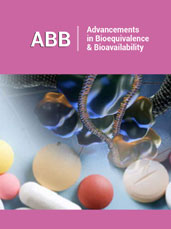- Submissions

Full Text
Advancements in Bioequivalence & Bioavailability
Edible QR Code for Personalized Medicine
Aly Nada*
Professor and Chairman of Pharmaceutics Department, Kuwait University, Kuwait
*Corresponding author: Aly Nada, Professor and Chairman of Pharmaceutics Department, Kuwait University, Kuwait
Submission: February 06, 2018 Published: April 10, 2018

ISSN 2640-9275 Volume1 Issue2
Letter to Editor
Majority of human beings, 99.9%, have the same genome bases. Remaining 0.1 percent makes a person unique, as reflected in different attributes, e.g. personal look, development of diseases. Some of the personal differences may be harmless (change in phenotype), harmful (diseases), or Latent (susceptibility to some diseases). Therefore, making medicines to suit particular patient (personalized medicine) is a hot topic in healthcare systems. Sequencing RNA can provide a broader understanding of a person’s state of health. Recent studies have linked genetic differences between individuals to RNA expression [1] translation [2] and protein levels [3]. Personalized medicine is also termed precision medicine, which is a medical procedure that separates patients into different categories with medical decisions, practices, interventions and/or products being tailored to the individual patient based on their predicted response or risk of disease [4].
The FDA has already taken initiatives to integrate personalized medicine into their regulatory policies. They developed a report in October 2013 entitled, “Paving the Way for Personalized Medicine: FDA’s role in a New Era of Medical Product Development,” in which future steps considered to integrate genetic and biomarker information for clinical use and drug development [5]. More recently, researchers have developed a new method for the production of medicine utilizing drugs in QR coded patterns using edible materials. By this way, the production can be tailored to fit each patient and has the potential to protect against wrong medication. Furthermore, the shape of a QR code enables storage of data in the dosage form and can detect counterfeit products. Accordingly, by doing a quick scan, one can get all the information about the product [6]. Hopefully, the researchers develop a printer capable of applying the drug in the QR code, while the edible base will be available in advance to respond to production of the medical drug near the end-users.
© 2018 Aly Nada. This is an open access article distributed under the terms of the Creative Commons Attribution License , which permits unrestricted use, distribution, and build upon your work non-commercially.
 a Creative Commons Attribution 4.0 International License. Based on a work at www.crimsonpublishers.com.
Best viewed in
a Creative Commons Attribution 4.0 International License. Based on a work at www.crimsonpublishers.com.
Best viewed in 







.jpg)






























 Editorial Board Registrations
Editorial Board Registrations Submit your Article
Submit your Article Refer a Friend
Refer a Friend Advertise With Us
Advertise With Us
.jpg)






.jpg)














.bmp)
.jpg)
.png)
.jpg)










.jpg)






.png)

.png)



.png)






